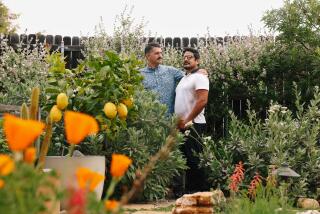Keeping Up With the Plot : A Journal of Your Garden’s Progress Doesn’t Just Record the Past, It Sketches the Future
- Share via
In my coat pocket is a piece of paper upon which is drawn a crude representation of a handsome plant. I made the sketch while trying to describe the particular plant to Shirley Kirens, who had sold it to me at a Huntington sale some time before. I wasn’t sure what it was, or when I bought it, or even when I planted it, because I have never managed to get a garden notebook off the ground.
Most great gardeners keep such logs, some of which have blossomed into literature. I’ve started many times and tried many systems, but literature, no; even the longest note wouldn’t qualify as a short story. Instead, I have piles and folders full of scraps of paper, much like the one referred to above, with bits of information on them. The Huntington managed to identify my plant as a Himalayan honeysuckle, so that piece of paper tells me its name. But it doesn’t tell me, among other things, that at some point in the year the honeysuckle has wonderful purple berries that hang from purple stems like party earrings.
In my attempts at keeping some kind of garden record, I have learned what is truly important to note and what is not. Size and color loom large on my list of vital information. I can remember what a plant looks like, but my memory is notoriously faulty when it comes to size and color.
I can accept a plant dying from improper care on my part. That is fate. But having one succeed and become a favorite and integral part of the garden, only to have to remove it because it has grown beyond expectations and is threatening others--that is most disheartening. Thus, the first thing on my list of notes to keep is how big and how fast a plant really grows--here in Southern California--since so much of what has been published applies to colder, harsher climates where plants are less bold.
Color in plants is exceedingly complex; simply saying that a flower is red is of no use. The rose ‘Ole’ is called red in most references, but plant it with other reds--or worse yet, with pink flowers--and you will quickly decide that it is orange. A note to that effect would save having to relocate a plant elsewhere, which I have done, twice, with ‘Ole.’
What about the other things to keep track of in the garden? Do you know in which months to fertilize citrus or, for that matter, when you last did? It is crucial, the timing of these feedings, almost as important as the timing for spraying for peach-leaf curl, which is incurable in any other season (now happens to be the time to do it). Using filing cards seems like a good system--one for each plant--but you soon find that all the facts don’t fit neatly. You could write this kind of information on a calendar, which works well enough if it is near the garden so that you don’t forget to note everything--or track mud into the house trying to. But calendars don’t work for random notes; on what day would you note how nice decomposed granite looks when it’s used as a path? The month you’re most likely to build one?
For that you need a notebook, a horticultural diary, the kind you can browse through while looking for ideas or inspiration. With a loose-leaf binder, you can rearrange your notes, but do you really want to? For me, the order in which I first learned of something is as interesting as the idea or information itself. It is this chronicling of a garden’s development, the ability to trace what you did right and what you will never do again, that makes note keeping worth the effort and that sometimes makes literature. The gardens we aspire to don’t come quickly or easily; you seldom get it right on the first try. But gardening is a renewable pleasure; each season gives you another go at it, which is why, this new year, I have purchased a nice, new notebook.
From the ruins of my other attempts I have formed a plan. I confess that my inspiration is somebody else’s success. Designer Tina Beebe began a garden daybook as an assignment for a class I was teaching, and it contains everything--the humdrum and the essential, such as “Sweet peas planted Oct. 9.” But what makes it sing are her drawings of real events in the garden, or events that could be--if this were combined with that , or if that were planted there . It is a sketchbook, a diary and a daybook, and it is good reading.
So that is my plan. All of my bits and pieces of paper will go into one book, even if I have to paste them on the pages. To that I plan to add pictures of pretty plants and gardens cut from magazines, snapshots of my own garden and others I have visited--even my own sketches. These I will surround with observations and notes. What I will end up with is a garden scrapbook, which might be something I can keep up with. Wish me luck.






